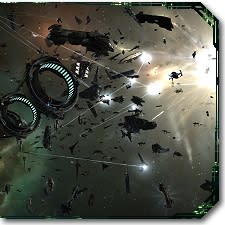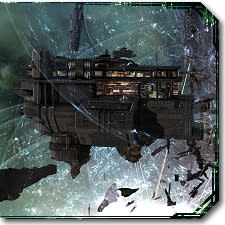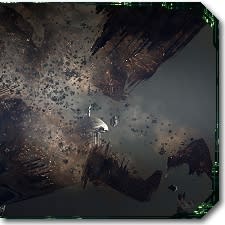EVE Evolved: The Bloodbath of B-R5RB
To the vast majority of gamers, EVE Online is an unforgiving sci-fi dystopia that's one part epic sandbox stories and nine parts spreadsheet. Once or twice per year, the gaming masses get a glimpse of the game's true depth when stories of incredible wars, political corruption, and record-breaking heists spread across the internet like wildfire. From the 2005 Guiding Hand Social Club heist that was plastered over the pages of gaming magazines to last year's infamous Battle of Asakai, tales of big events from EVE have always managed to grab the gaming media's attention.
This week saw the largest record-breaking battle to date as a total of 7,548 players belonging to EVE's two largest megacoalitions fought for control of an innocuous dead-end solar system in the Immensea region. A total of 11 trillion ISK in damage worth over $310,000 USD was inflicted during what has now become known as The Bloodbath of B-R5RB and is allegedly the largest PvP battle in gaming history. The odd story of how the fight started and its record-breaking destructive scale are both big news, but the unsung heroes of B-R5RB are the people who work behind the scenes to ensure that the server can remain online during major battles.
In this week's EVE Evolved, I look at how one player forgetting to check a box on a form sparked this immense battle and how technologies like Time Dilation help to keep the server online when the ship hits the fan.
The biggest battle in gaming history
The past few years have seen EVE transformed from a persistent sandbox MMO with a few hundred thousand subscribers to a global gaming spectacle. Anyone who's been involved in alliance warfare or a particularly good heist will know how epic it feels, and yet EVE remains a difficult game for the majority of gamers to get into. Those walls are now starting to come down due to the ever-increasing popularity of livestreaming and the growing trend of people watching online games as spectator sports. When an event like The Bloodbath of B-R5RB happens today, links to the streams flood through Reddit and social media.
The Bloodbath of B-R5RB wasn't just the largest PvP battle in EVE Online's decade-long and violent history, but also potentially the largest recorded PvP battle in any game to date. A total of 7,548 players from the warring coalitions participated in the 21-hour-long fight, which saw the destruction of 73 Titan class capital ships worth almost $3,000 US each. Last year's battle in 6VDT-H remains the fight with the highest peak population at a world record 4,070 but had far fewer players involved in total and a lot less destruction by ISK value of the destroyed ships. This week's battle only peaked at 2,670 players as the carnage was spread out over so many hours, but it was larger in every other way.
How did the fight start?
Politics and war in EVE Online are subtle games in which alliance leaders carefully consider strategic options, aiming to deal as much damage as possible without exposing their own members to significant risk. Last year's Battle of Asakai showed that major battles can easily erupt from strategic mistakes such as a titan accidentally jumping into a vulnerable position. So it was again with the Bloodbath of B-R5RB, which all started because someone forgot to check the auto-payment box in his alliance's wallet. On January 27th, ownership of this strategically valuable solar system dropped due to an unpaid sovereignty bill.
Missed bill payments have claimed entire alliances in the past, causing one to be disbanded in 2010 and throwing entire regions of space into disarray. Though only a single system was up for grabs this time, it was an important staging point for war in the south of EVE and the game's two largest coalitions both had their eyes on it. A conglomeration of CFC and Stainwaggon seized the opportunity to steal the solar system, and a coalition containing Pandemic Legion, Northern Coalition, and Nulli Secunda responded in force. The battle started and ended badly for Pandemic Legion and its allied groups, which lost 58 titans, 11 supercarriers, and 371 capital ships, in the most expensive single-battle loss in EVE history.
How did the server cope with the load?
In years gone by, fights like this would have caused the server to lag out and ultimately crash. Players even figured out the best ways of generating lag to force a node death and save their ships from destruction, such as repeatedly switching ammo types and ungrouping guns. Warring fleets containing hundreds or thousands of players would often wait on either side of a stargate and dare each other to jump across to the other side, as the players jumping in would experience the worst lag of all. Alliance leaders could request a dedicated server for battles, but the request had to be made at least 24 hours in advance.
All of this changed with the advent of time dilation in 2011, which I maintain is the single most inspired feature in any MMO to date. When too many people pile into one solar system and the server node starts to get overloaded, time itself begins to slow down in the system to compensate. All physics interactions occur less frequently, ship movement slows, weapon fire rates decrease, and the game essentially plays normally except that everything is in slow motion. The slowdown grows in intensity as server load increases, eventually bottoming out at 10% of normal game speed. The result is dramatically reduced server load, allowing a server that could previously support only 200 people before lag set in to comfortably hold thousands.
There's always been something about watching the drama of huge player-driven events like the Bloodbath of B-R5RB or the Battle of Asakai unfold that entices the average gamer, and experiencing battles such as these first-hand as a player is a truly unique experience. But events of this scale are possible only because EVE Online takes place within a single player-run universe without instances or shards separating players, and there's a fair amount of server magic keeping that running.
Developers can now reinforce star systems dynamically and without advance notice by moving all other solar systems on the same node onto to other hardware. Time dilation helps further by slowing down time on the server to decrease the load, and it has the added effect of extending the duration of major battles. Reinforcements can now realistically arrive in time to make a difference, news of the fight can spread across the internet, and everyone watching via livestreams has time to grab some popcorn and watch the fireworks.

Brendan "Nyphur" Drain is an early veteran of EVE Online and writer of the weekly EVE Evolved column here at Massively. The column covers anything and everything relating to EVE Online, from in-depth guides to speculative opinion pieces. If you have an idea for a column or guide, or you just want to message him, send an email to brendan@massively.com.






